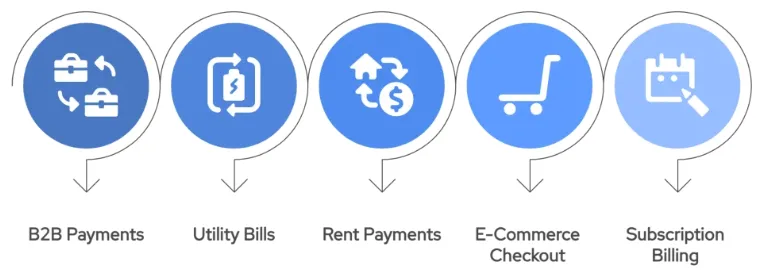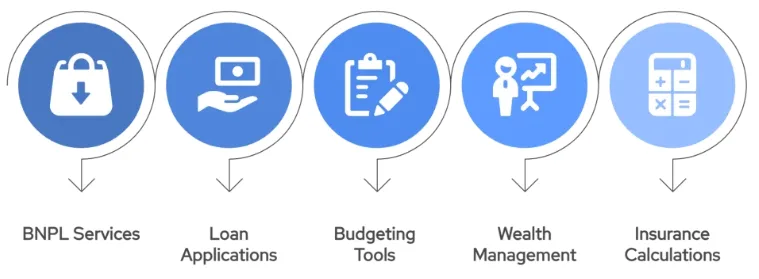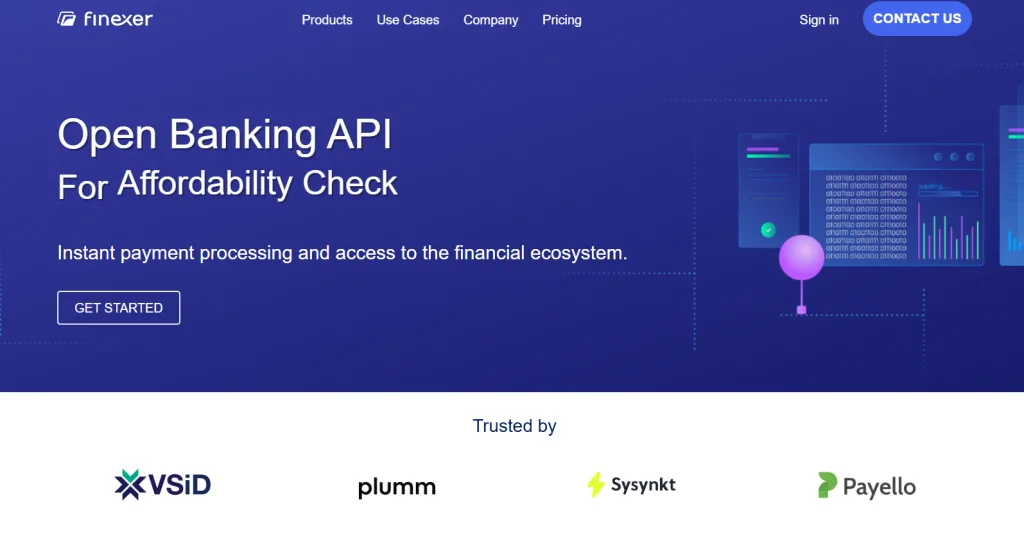Open banking now powers billions of transactions across the UK, enabling businesses to build new financial services that were once impossible. In 2024, the UK’s Faster Payments scheme alone processed over 5.7 billion transactions many of which leveraged open banking rails for real-time transfers.
At its heart, open banking gives customers control over their financial data, allowing them to grant consent for third-party providers to access account information or initiate payments. The result: seamless, secure access to financial services that bypass traditional card rails, reduce fees, and speed up settlement.
Finexer’s UK-first open banking infrastructure offers connection to 99% of UK banks, with FCA-authorised APIs that help businesses roll out payment and data services faster and with full regulatory compliance.
These open banking examples show how UK organisations are already applying the technology from supplier payments to automated underwriting to drive cost efficiencies, improve risk assessment, and deliver modern user experiences.
What Is Open Banking?
Open banking is a way for people and businesses to securely share their financial data with trusted third-party providers. Instead of downloading bank statements or manually entering information, customers can give permission for a provider to connect directly to their bank through secure, regulated APIs.
There are three main things this makes possible in the UK:
- Account Information Services (AIS) – viewing and analysing real-time bank data like transactions and balances.
- Payment Initiation Services (PIS) – sending payments straight from a bank account without relying on cards.
- Variable Recurring Payments (VRP) – flexible, consent-based payments that can change month to month (for example, utility bills or usage-based subscriptions).
Every provider offering these services must be authorised by the Financial Conduct Authority (FCA). This ensures that data is protected, transactions are secure, and customers stay in control at all times.
For businesses, the idea sounds promising but actually connecting to every major UK bank and staying compliant is a big technical lift. Finexer solves that problem by acting as the regulated bridge. Instead of building dozens of bank connections and navigating regulatory approvals, companies can use Finexer’s infrastructure to get secure, real-time access to 99% of UK banks in one go. It’s how teams move from theory to production without spending months on groundwork.
Payment Solutions — Direct Bank Transfer Examples

Open banking isn’t just a concept anymore. Across the UK, businesses are already using open banking payments to collect funds faster, cut processing fees, and remove friction from everyday transactions. Here are five practical open banking examples that show how direct bank transfers are replacing card-heavy payment flows.
1. Instant B2B Payments
Business-to-business payments often involve large amounts, making card networks expensive and restrictive. With open banking, companies can transfer funds directly between bank accounts in seconds. Many manufacturing and wholesale firms now pay suppliers this way, reducing processing costs by up to 3 percent and avoiding card limits entirely. Payments that once took days now clear almost instantly.
2. Utility Bill Payments
Energy and water companies are using open banking payments to give customers more control over how they pay. Instead of relying on card details or rigid direct debits, customers can approve secure one-off or recurring payments through their bank. This approach lowers failed payment rates and gives utilities more predictable cash flow, while customers like the flexibility to authorise payments on their terms.
3. Rent and Property Payments
Property managers are adopting variable recurring payments through open banking to modernise rent collection. Tenants can set up flexible payment agreements that automatically adjust each month if the amount changes (for example, with service charges). Landlords receive funds faster, admin teams spend less time chasing payments, and tenants don’t need to remember standing orders or card renewals.
4. E-Commerce Checkout Options
Online retailers are adding open banking payment gateways at checkout alongside traditional card options. Customers pay directly from their bank account in a few taps, without entering card details. Retailers benefit from lower fees, no chargebacks, and faster settlement times, while shoppers trust the security of their own banking app. Some fashion retailers have even seen higher conversion rates for larger purchases when offering this option.
5. Subscription and Membership Billing
Gyms, SaaS platforms, and membership organisations are starting to use variable recurring payments via open banking to handle flexible billing. Unlike direct debits, these payments can adapt each month depending on usage or plan type. Customers see exactly what they’re approving through their bank, which builds trust and reduces disputes.
These payment-focused open banking examples show a clear trend: direct bank transfers are moving into spaces once dominated by cards and manual processes. Businesses are finding faster ways to get paid, and customers are gaining more control and transparency over their transactions.
Data and Analytics Applications

Open banking isn’t just changing how money moves, it’s also reshaping how financial data is collected, analysed, and applied in real-world decisions. Through regulated APIs, businesses can securely access real-time bank data that was once buried in statements or portals.
Here are five open banking examples where smarter use of data delivers stronger results.
6. Credit Scoring and Lending Decisions
Traditional credit checks rely on historic data that may no longer reflect someone’s financial reality. With open banking APIs, lenders can view live income streams, cash flow, and spending habits. This enables faster lending decisions and makes it possible to serve customers with thin or no credit history more fairly.
7. Real-Time Financial Health Monitoring
Accounting and business finance platforms are embedding open banking feeds into dashboards. This gives small businesses live insights into cash flow and spending, helping them react quickly to unusual activity or potential shortfalls. Instead of waiting for reconciliations, they can manage their finances proactively.
8. Automated Expense Categorisation
Expense platforms are using open banking API examples to automatically categorise business transactions. Payments are matched against receipts or policies in real time, so employees spend less time filing reports and finance teams get an accurate view of company spend without manual input.
9. Fraud Detection and Prevention
The richness of real-time banking data makes fraud monitoring much more effective. By analysing transaction patterns through open banking, fintechs can flag suspicious activity the moment it happens. This approach gives banks and businesses a better chance of stopping fraud before losses occur.
10. Invoice Financing and Factoring
Lenders offering invoice financing need to assess a company’s cash position before advancing funds. With open banking data, they can see incoming payments, revenue cycles, and overall account health instantly. This reduces approval times from days to hours, giving businesses faster access to working capital while lenders make decisions based on real evidence rather than static statements.
These open banking examples prove that access to live financial data isn’t just about compliance — it’s becoming a competitive advantage. From smarter lending to sharper fraud prevention, businesses that adopt open banking APIs are turning raw transaction data into valuable insight.
Personal Finance & Lending Applications

Open banking is also transforming how consumers borrow, budget, and invest. By giving service providers real-time access to verified financial data, processes that once involved stacks of paperwork and long waiting times can now happen almost instantly.
Here are five more open banking examples that highlight its impact on lending and personal finance tools.
11. Buy Now, Pay Later (BNPL) Services
BNPL providers are using open banking to run instant affordability checks before approving payments. Instead of relying on credit bureaus alone, they analyse a shopper’s recent bank activity to assess whether they can handle the instalments. This helps them make faster decisions at checkout while managing default risk more effectively.
12. Mortgage and Loan Applications
Mortgage brokers and lenders are integrating open banking to remove a major bottleneck: document collection. With the customer’s consent, they can access verified bank data directly, eliminating the need for months of statements. This gives underwriters a full picture of income stability and spending habits, speeding up approvals and improving accuracy.
13. Budgeting and Savings Tools
Personal finance apps now use open banking data to pull in transactions from multiple bank accounts into one dashboard. Users can set savings goals, track their spending, and get personalised tips based on their actual financial behaviour — not generic averages. It’s a cleaner, smarter way to manage money day to day.
14. Investment and Wealth Management
Robo-advisors and wealth platforms are leveraging open banking to give clients a clearer financial picture. By analysing income flows, spending patterns, and available balances, they can recommend investment strategies that align with real-life financial situations. Portfolios can also be automatically rebalanced as cash flows change, making wealth management more responsive.
15. Insurance Premium Calculations
Insurers are starting to use open banking to move away from one-size-fits-all pricing. For example, travel insurers can base premiums on actual travel spending, and business insurers can use real revenue data to offer more accurate pricing. This data-driven approach benefits both sides: fairer premiums for customers and reduced underwriting risk for insurers.
Business Banking & Emerging Use Cases

For many UK businesses, open banking has become more than a payments tool — it’s now part of everyday operations. From cash flow forecasting to regulatory reporting, companies are finding new ways to use real-time bank data to cut admin work and strengthen decision-making.
Here are the final five open banking examples that highlight its growing role in business banking and beyond.
16. Cash Flow Forecasting
Accurate forecasting depends on up-to-date financial information. Business banking platforms are using open banking feeds to analyse historical patterns and future obligations, giving companies a clear view of their cash position weeks in advance. This helps finance teams avoid overdrafts, plan payments, and make better investment decisions.
17. Multi-Bank Account Management
Large companies often hold accounts across several banks. Instead of logging into multiple portals, open banking connections allow treasurers to view all balances, initiate payments, and optimise cash positions from a single dashboard. This reduces operational risk and saves hours of manual work.
18. Automated Reconciliation
Matching transactions to invoices is still one of the biggest pain points for finance teams. By pulling in real-time bank data through open banking APIs, accounting software can automatically reconcile incoming payments with outstanding invoices and purchase orders. This removes manual checking, reduces errors, and provides a clearer view of receivables.
19. Carbon Footprint Tracking
A growing number of environmental fintechs are using open banking data to calculate personal and business carbon footprints. By categorising transactions and applying carbon intensity factors, they can estimate the environmental impact of spending patterns. It’s a good example of how open banking data is powering entirely new service categories.
20. Regulatory Reporting and Compliance
For regulated firms, compiling accurate reports can be time-consuming. Open banking allows financial data to flow directly into reporting systems, reducing the need for manual uploads or reconciliations. This improves accuracy, lowers compliance costs, and helps businesses keep pace with FCA requirements without drowning in paperwork.
How Finexer Helps with These Use Cases

The impact of these open banking examples goes beyond technology. The real value lies in the tangible outcomes they deliver for UK businesses and their customers, from reducing costs to improving speed, security, and operational control.
1. Lower Transaction Costs
Shifting payments from card networks to direct bank transfers can reduce transactional costs by up to 90%. For retailers, utilities, and B2B firms processing large volumes, these savings quickly become substantial.
2. Faster Settlement Times
Open banking payments clear in seconds through the Faster Payments network, unlike card payments which can take days. Quicker settlements strengthen cash flow and reduce reliance on credit.
3. Higher Security Standards
FCA regulations and strong customer authentication make open banking transactions inherently secure. Customers authorise payments within their own banking app, so merchants never handle sensitive card details, lowering fraud exposure.
4. Better Customer Experience
Features like variable recurring payments, bank-to-bank checkout options, and consolidated account views make everyday interactions simpler and faster for customers while businesses benefit from fewer drop-offs and disputes.
5. Operational Efficiency
Real-time bank data removes manual steps in reconciliation, reporting, and onboarding. Finance teams spend less time chasing information and more time on strategic tasks.
Finexer provides the infrastructure to make all of this happen.
Instead of building dozens of integrations and navigating complex regulatory approvals, businesses can connect to 99% of UK banks through a single, FCA-authorised platform. Finexer enables instant access to payment initiation and data services, so teams can deploy these use cases 2–3x faster and focus on delivering value to their customers — not wrestling with compliance and connectivity.
What is an example of open banking in the UK?
One clear example is how mortgage brokers use open banking to access applicants’ financial data directly (with consent), removing the need for months of statements and speeding up loan approvals.
Are open banking payments secure?
Yes. All providers must be FCA-authorised and use strong customer authentication. Customers approve payments through their own banking app, which keeps credentials private and protected.
How do open banking API examples work in practice?
Developers use regulated APIs to connect to multiple banks, fetch live transaction data, or initiate payments with customer consent — all without building separate connections for each bank.
We can help you launch open banking solutions faster and more cost-effectively than traditional providers so, Book a Demo Now!
